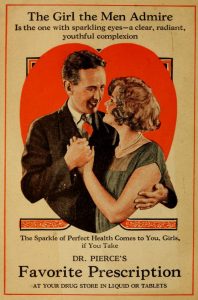opium

The sparkle of perfect health
ADvent Calendar Day 12 The Favorite Prescription was just one part of a range marketed by Dr Ray Vaughn Pierce in newspapers, almanacs, pamphlets and on the side of barns across the late 19th-century US. After his death in 1914, his profitable business continued in the hands of his son, Dr Valentine Mott Pierce, and […]
Read MoreAtkinson & Barker’s Royal Infants’ Preservative
Source: The Patriot (London) 12 September 1853 It is no misnomer Cordial! —no stupefactive, deadly narcotic! —but a veritable preservative of Infants! Regular readers of The Quack Doctor might be able to hazard a guess at the active ingredients of this product. Like other infant quieteners, it did contain a narcotic, and, like them, it […]
Read MoreThe Elixir of Opium podcast, plus award news
A couple of weeks ago a I did a post about McMunn’s Elixir of Opium, and because I had quite a bit of information about it, I intended to do a podcast. Unfortunately I was suffering from the worst cold ever (N.B. every cold I have is the worst cold ever) so I couldn’t speak […]
Read MoreMcMunn’s Elixir of Opium
Source: Western Journal of Medicine and Surgery (Louisville, KY), July 1855 Click here for Transcript There are no prizes for guessing what was in this. First formulated in the mid 1830s by Dr John B McMunn (or M’Munn), it became a big hit in the US once a drug company called A B Sands bought […]
Read MoreSir John Hill's Pectoral Balsam of Honey
Sir John Hill (the “Sir” came from a Swedish title) started out as an apothecary and also tried his hand at acting before becoming a prolific writer. He edited the British Magazine from 1746-50 and produced a huge variety of works including plays, advice on marriage and child-rearing (under the pen-name The Hon. Juliana-Susannah Seymour), […]
Read MoreMrs. Winslow's Soothing Syrup
Originating in New York in the 1840s, Mrs. Winslow’s Soothing Syrup was a dangerous concoction. Parents often did not realise that it contained morphine, and sadly, as the American Medical Times put it in 1860, were “relieved of all further care of their infants” through its use. ADVICE TO MOTHERS!—Are you broken […]
Read MoreBarclay's Dr. Bateman's Pectoral Drops
Bateman’s Drops had been around since the 1720s and were prepared by various suppliers, hence the specification that these were Barclay’s Bateman’s Drops rather than anyone else’s. The main ingredients were aniseed, camphor and opium, so the drops would have at least a temporary effect and could be rather dangerous if swigged indiscriminately. Different suppliers […]
Read More